According to Oberlo, more than two-thirds (63%) of customers begin their shopping journey online with up to 50% of customers globally preferring to shop on their mobile phones rather than physically in a store. This means that no matter where the customer eventually makes their purchase, they will begin their research using the internet.
As a business owner, being online is the best thing you can do. With smartphones accompanying us everywhere we go, the opportunity to shop on the net is greater than ever. People can shop on the bus, queuing for a coffee, or as soon as they wake up in the morning. There’s no time a customer can’t make a purchase – except perhaps in the middle of an exam or at the top of a mountain.
The great news is that anyone can start an online business. You don’t even need an office to get going; remote working is becoming increasingly popular. All you need is a computer. The internet has created a wealth of opportunity, and anyone with a good idea or product and the willingness to put in the hard work can use it to their advantage.
The thought of starting an online business as your full-time endeavour might be daunting, but this step-by-step guide is designed to inform, enlighten, and educate. It’s time to start your very own online business.
Business trends to know when starting an online business
The great thing about eCommerce is that it’s easy to detect patterns and trends. Every online activity is tracked and traced – as spooky as that might sound. And knowing the current trends is important if you want to start an online business, especially if you are forming a private limited company through a registered agent. You can identify what people like and want to see more of. Below are some of the current trends to give you some online business ideas.

Image from Ikea.com
- Augmented reality (AR)
Will the glasses suit you? Will the sofa fit in the corner? Will the makeup match your skin tone? AR is quickly becoming popular in retail, and its growth doesn’t seem to be slowing down. It gives shoppers the chance to get a lifelike idea of how a product will look, without leaving the comfort of their own homes.
- Artificial Intelligence
Yep, following the Black Mirror tone, AI is becoming increasingly popular for the retail experience. Chatbots are being used to communicate with existing and potential customers, and self-checkouts are being used in online clothing stores as well as supermarkets.
- Mobile shopping
Mobile shopping is a current online trend that more and more companies are using. How does it work? It can be used to combine the online and in-store shopping experience, creating a smoother customer relationship. Many brands do it well by using an app to create rewards and show customers how to use certain products.
It’s cool to care about the environment. But let’s face it. Capitalism and sustainability strategies. don’t often go hand in hand. This applies particularly to online shopping, with wasteful packaging contributing to landfill and damaging our planet. Those looking to start an online business will need to think about being eco-friendly and using biodegradable packaging.
How to Start an Online Business in the UK
Starting a business can feel overwhelming at first. This ultimate guide takes you from the very beginning to the very end. So, where do you start?
1. Market-Research.
That’s right; the first step in starting an eCommerce store is conducting market research. There’s no point selling something for which there’s simply no demand – or which is the same as another business.
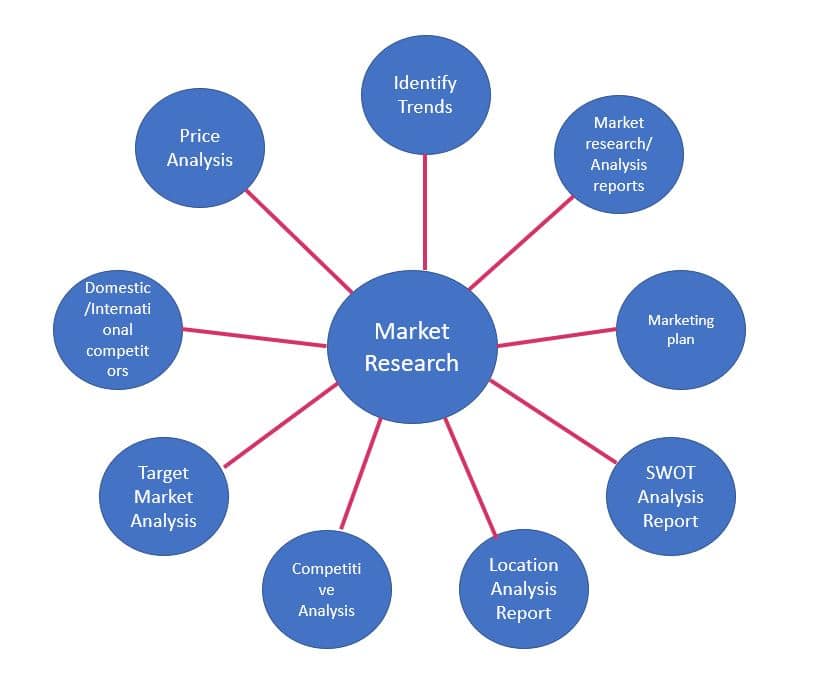
Image from Sapioresearch.com
But what exactly is market research in the context of online businesses? Put simply, and it’s an organised effort to gather information about target markets and customers. You aim to know about them, starting with who they are. Here are the top three steps of conducting market research.
a. Find a niche.
Finding your niche is key in starting an online business. But how do you do it? Leadership team coach, Jeff Boss, says you can do it in just four steps:
1. Identify the talents and skills you have: This means being realistic and putting any judgements aside. Don’t lie to yourself. Learn how to separate the things you want to be good at, from the things you actually are good at. It’s important to be as honest and transparent as possible here, as your answers will shape the rest of the process.
2. Out of the above talents and skills, what do you enjoy doing most? It’s important to do something you love. Starting an online business is a lot of work, so pick something that you care about and can see yourself working on every day. Otherwise, what’s the point?
3. Of those talents and skills you enjoy, what do people need? Business is all about establishing a need. Amazon established that people needed next day delivery and – huzzah! – Prime was born. Your “niche” should never be so “niche” that people don’t need it.
4. From the above needs, what will people pay big money for? Yes, you want to make money from your online business. So, think about scalability. If one person will buy your product, will twenty? A hundred? How much will they pay? Aim for big money.

b. Finding a product.
Now that you know your niche, what are you going to sell? An online business needs a product. Whether that’s funky t-shirts, hiking gear, or contact centre products, you need to ensure that your offerings are good quality and appeal to a mass market.
There are several different strategies for online business owners. Some might already have a product. In fact, your online business might result from a product you already know you want to sell. For example, an artist might want to start an eCommerce website to sell their art. In which case, you already know your product.

Image from Unsplash.com
Others might already know the area they’re interested in, but they don’t yet have their product. Take Eric Bandholz, for instance. He created the blog Beardbrand to discuss business ventures. But, as time passed, he began to weave beards into the equation, and eventually created a successful eCommerce business selling beard grooming products. Did he know his product when he started the blog? Probably not.
Alternatively, you might have no idea what you want to sell. Here’s where your market research comes in handy. Searching for keywords, for example, can help to assess what people are regularly searching for. This means that you can sell a product which is in high demand. Go one further by checking out what’s trending on online marketplaces like Amazon, Etsy, and eBay. Tools like JungleScout can help with this, too.
Finding your product is important, but it might not necessarily be the be-all and end-all. You can always adapt your product over time. The key is to get going and research along the way.
c. Finding an audience
Your audience is your customers. The best thing an online business owner can do is to know their customers. While it’s important to all business owners, it’s crucial online. You don’t communicate face-to-face, so it can be easy to feel disconnected.
While a good marketing strategy and online presence will help to sell your products, you don’t get the chance to persuade your customers in-store. So, you need to know what they’re looking for.
Finding an audience seems tricky, but the internet is clever. It knows how to get the facts. Social media platforms like Twitter, Facebook, or Linkedin, for example, are great ways to monitor activity and detect who is paying attention to your brand. Asos does this well. You can also conduct user surveys and use Google Analytics or email lists.
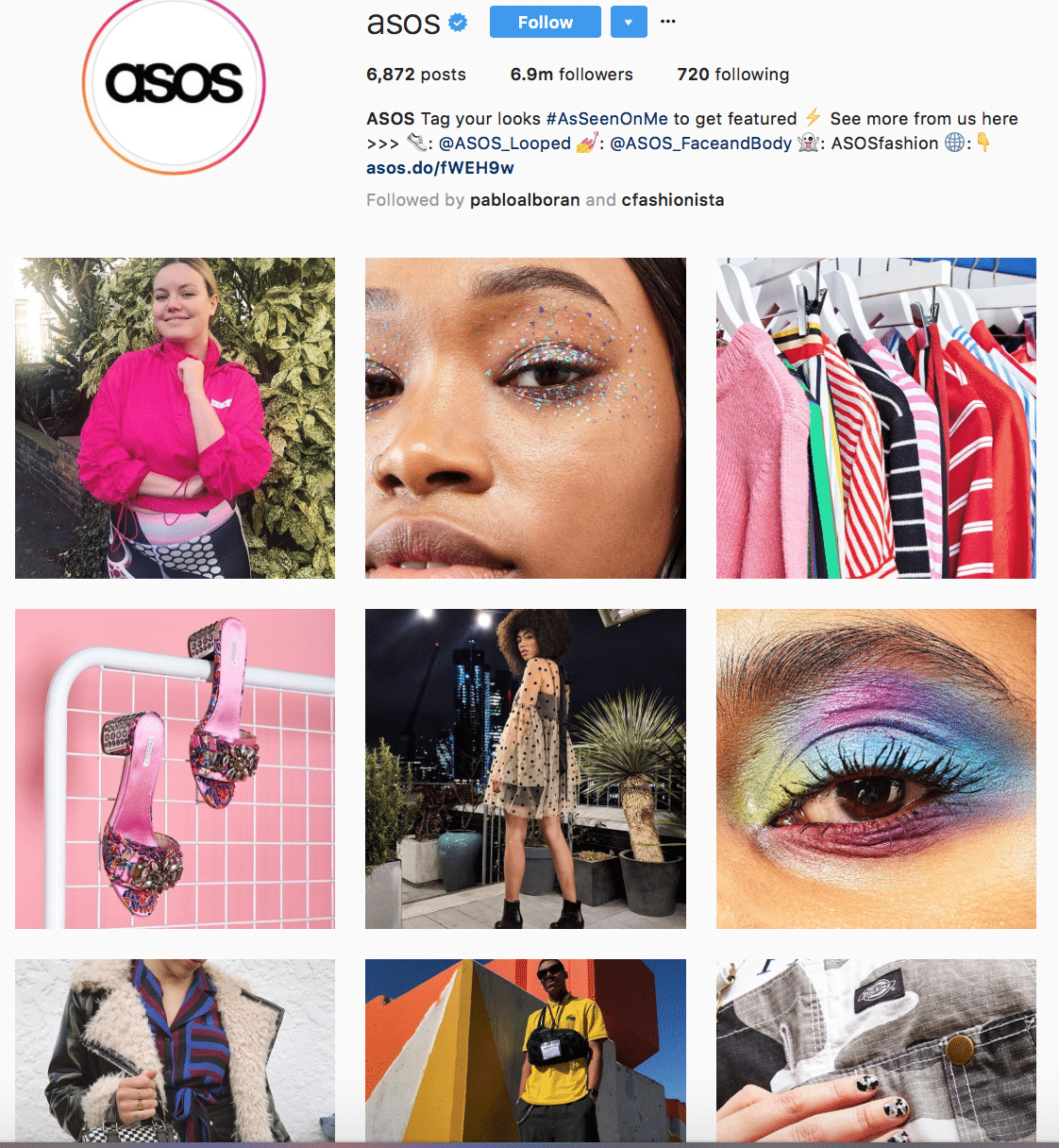
Source: medium.com
And, check out your leading competitors’ customers and ask them questions. The more you know, the better your business will be.
2. Competitive analysis.
Competitive analysis is all about understanding your competitors and assessing their strengths and weaknesses. By doing so, you can:
- Identify gaps in the market
- Develop new products and services
- Uncover market trends
- Market and sell more effectively
- Set more competitive pricing
- Learn the mistakes to avoid for your own website
First things first, you need to determine who your competitors are. These can be divided into two types:
- Direct competitors: these are businesses that offer products or services that might be considered a substitute for yours. They also operate in the same geographic area.
- Indirect competitors: these provide different products to yours, but could satisfy the same customer need or solve the same problem.
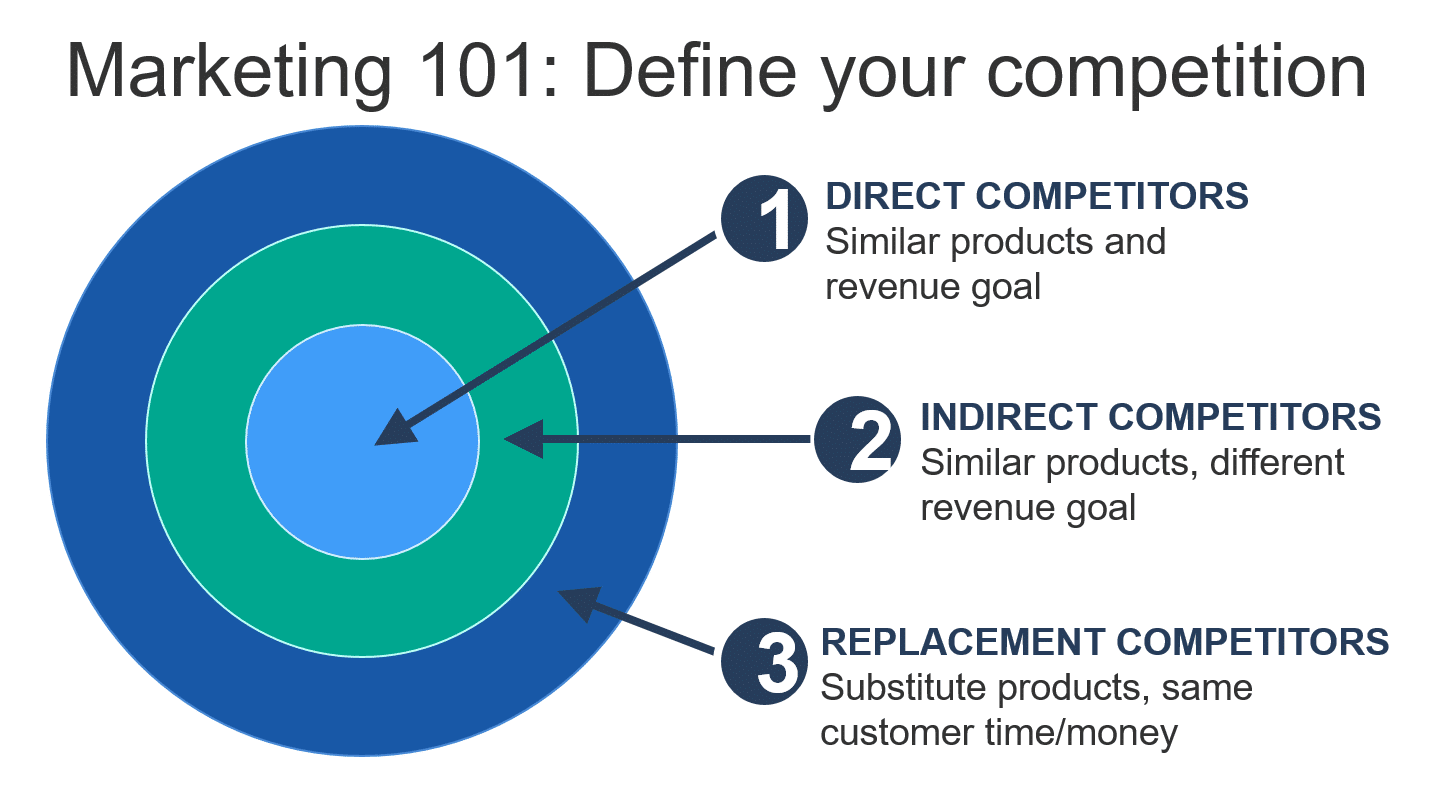
Graph from Marketingsherpa.com
Confused? Let’s say your online business is going to sell coffee. A direct competitor would be the leading brands: Nespresso, Starbucks, Costa, etc. An indirect competitor might sell mineral water. You want to focus on your direct competitors instead of the indirect ones. How?
a. Study the competition and carve out how your voice will be different.
You need a different voice. There’s no point starting an online business that sounds the same as your leading competitors. The key is to show some hustle, stand out, and offer customers something similar, but slightly better.
Take Dental Bliss. They established that many people hate going to the dentist because it feels cold, clinical, and anxiety-inducing. So, they changed the tone and created a luxury, spa-like dental experience. Patients can enjoy refreshments while they’re waiting and wear noise-cancelling headphones to eradicate the noise of dental tools. It’s a unique dental experience. They found their voice and stood out from the crowd.

Image from Dentalbliss.com
This takes us back to that word again; ‘niche’. Being different often means being specific. It means thinking outside the box. Offering a service that no one else does.
As a new business, people will be sceptical. They know that Nespresso is trustworthy and reliable, so they’ll pick Nespresso over you every time if your services are the same. How can you be different from Nespresso? Funky flavours? A different target audience? Sustainability? The possibilities are endless when you identify what the market is missing.
3. Build your brand.
“A brand for a company is like a reputation for a person. You earn reputation by trying to do hard things well” – Jeff Bezos, Amazon.
Every online business has a brand. The better the brand, the better the business. All small business owners will press the importance of building a brand. It’s not something that happens by magic. It will take longer than you expect, and shouldn’t be rushed. Here are six steps when building a brand:
- Pick your focus and personality:
After doing your market research and studying the competition, it’s time to start thinking about your focus. Whether you’re giving business advice through webinars or selling hats, you need a personality. A business voice. Are you fun and young? Serious and strategic? Millennial? You need to know this before you move onto the next steps.
- Choose your business name
the name is important. It needs to be memorable. Short and sweet is usually best. Having meaning gives it an extra layer of purpose. Also, think about the domain name when choosing a legal moniker. Check out these tips from Forbes.
- Write your slogan
“Every little helps”, “Because you’re worth it”, “Just do it”. Every business owner can learn from Tesco, L’Oreal, and Nike because their slogans are iconic and memorable. Yours should be, too. Pick something that stands out and rolls off the tongue.
- Choose the look of your brand
All brands stick to a colour scheme. Take the leading British supermarkets. Tesco is red and blue. Asda is green. Sainsbury’s is orange. Check out your leading competitors and make sure you pick a different colour scheme, so you don’t confuse customers. Your font should be consistent across brand messaging, too.
- Design your logo
Every brand needs a great logo. Pick something that stands out, is easy to read, and draws attention to your business.
- Apply your branding across your business
It’s time to be consistent. Your branding needs to go everywhere. It should all match. This means putting it on your website, any leaflets, on email campaigns, and so on. Get your name out there.
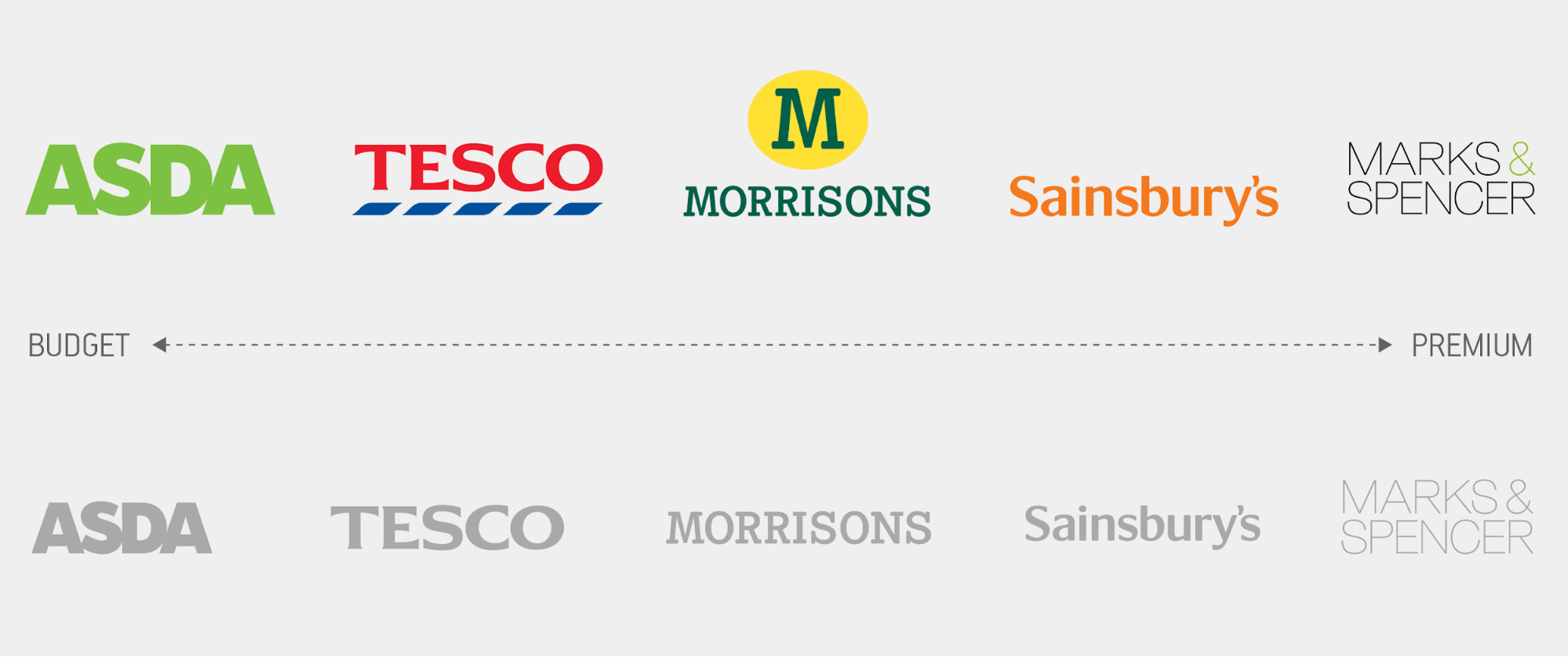
Image from arkafrica.com
4. Create a business plan.
Let’s face it; Jeff Bezos didn’t wing it. All businesses start with a good plan. Creating a sturdy, fool-proof business plan is a great skill. You will need all the tools and equipment available, from financial software to journals, to advisors. But how do you create a business plan?
a. Look for investors to finance your business start-up
While you might be able to start your online business with just your computer, a little financial leverage always helps. Even online, startup costs can rack up quickly. Looking for investors can be a great way to start up your business.
Of course, the chances of receiving a call from a generous benefactor are pretty slim. You need to know how to attract investors yourself. You can do so by using:
- Government-backed business grants and loans: These are disbursed to small business start-ups and existing businesses by the UK government and the various county councils. Different county councils such as Kent, Devon and Warwick have business and start-up financing programs targeting diverse sectors based on their economic goals.
- Online fundraising platforms: such as Crowdfunder and Indiegogo
- Email: reach out to an investor through a simple email
- Hosting events: concerts, talks, and even events such as online courses and webinars will raise your profile
- Blog: it’s all about navigating traffic
- Social media: posting regularly will attract attention
- Accelerator programs: these often have open invitations for applications from serious entrepreneurs
b. Register your business with the relevant UK authorities
Your firm, whether big or small, must be registered in order to remain compliant with the relevant laws. Before registering your business, you need to know about online business laws. There are a lot of them. Some of the things you’ll need to know about include:
- Taxes- Is your business registered with the HMRC to enable you to pay taxes?
- Shipping restrictions-What are the shipping restrictions for the goods you will be shipping as per the health and safety laws? What information do you need to disclose to the National Clearance Hub when shipping goods in and out of the United Kingdom?
- Business insurance- What insurance covers do you require for your businesses and the type of goods you will be shipping?
- Trademarks and copyrights- Is your product patented and could you be selling a product patented by someone else unknowingly?
- Inventory- What rules on inventory production and storage are you required to be compliant with?
- Payment gateways-Is your business registered with the Payment systems Regulator to allow them to regulate your payments?
- Age restrictions-What are the age restrictions for the kind of products you will be selling to customers?
- Licenses and permits- What permits do you require from the local council and relevant regulatory bodies in order to be allowed to trade?
Brush up on the facts and make sure you aren’t breaking any laws when you start selling. It’s not worth risking your business.

c. Test your ideas.
A good business plan always involves testing ideas. This phase is key to starting a successful online business as you don’t want to invest a lot of money and time into a product without assessing whether it’s something that people are interested in.
In their book, Testing Business Ideas: A Field Guide for Rapid Experimentation, Alexander Osterwalder and David J. Bland established that 7 out of 10 new products fail to deliver on expectations. Their book gives helpful advice for new business owners and contains a library of hands-on techniques for rapidly testing new business ideas. It aims to:
- Increase the success of any venture and decrease the risk of wasting time, money, and resources on bad ideas;
- Close the knowledge gap between strategy and experimentation/validation; and
- Identify and test your key business assumptions with the Business Model Canvas and Value Proposition Canvas.
As a new online business owner, it’s a valuable read that will teach you more about the importance of testing your ideas and the best methods to use.
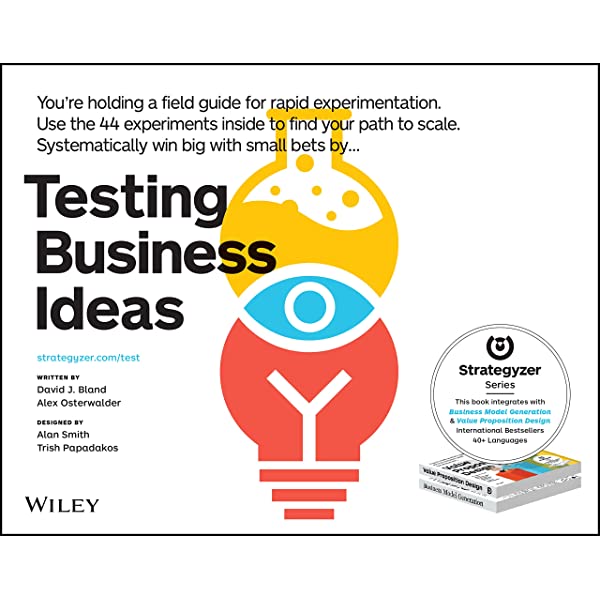
Image from Amazon.com
5. Start sourcing materials to create your products.
Selling can be difficult, and empathetic selling is more important now than ever. But how do you get the products to sell?
It’s time to source your products. Put simply, this the process by which a business attains a product to sell. There are a variety of methods by which sellers source their products, including:
- Wholesale: to sell products in large quantities at low prices (i.e. most retail stores and supermarkets).
- Dropshipping: the seller accepts customer orders but does not keep goods sold in stock.
- Print on demand: individual copies or small numbers of a product are printed to order, typically using digital technology (this is often how prints work via art sites such as Etsy).
- Custom manufactured: a unique product is designed or engineered to order for a single customer.
There are three primary sourcing options to consider:
- DIY products or services: this is the option for those creating their own products. I.e., an artist setting up an online business to promote and sell their own creations. You don’t need to product source because you’re creating the products yourself.
- Work with a manufacturer or wholesaler: this is the most popular option for most successful online businesses. It means you’re hiring a partner to develop your products. It involves creating a business relationship with your supplier.
- Hire a drop shipper: this allows you to purchase from a vendor and sell their products on your store. The vendor charges you for the product, but ships on your behalf. It’s a great option for a simple process. However, it means that you’ll have more competition as you aren’t selling original or unique products. Customers can always buy them elsewhere.
So, if you’re looking to work with a manufacturer, wholesaler, or drop shipper, how do you find suppliers?
a. How to find suppliers.
Finding suppliers for your online business isn’t as difficult as it may seem. You have the internet at your disposal, after all. But, more specifically, here are the most efficient ways to find suppliers:
- Directories: there are lots of free online directories that function to help businesses connect. Thomasnet is a great domestic directory, whereas Indiamart is popular for overseas suppliers.
- Google: this one hardly needs explaining. However, many suppliers haven’t kept up with Google algorithms, meaning you’ll have to search wisely. Try using a variety of search terms and familiarise yourself with Google shortcuts. There may be some great suppliers hiding on page two of your Google search, too.
- Local library: going to your local library might seem old-fashioned, but many pay monthly subscription fees for online business and manufacturer directories that you normally wouldn’t have access to – certainly not for free. So, it’s worth checking.
- Referrals: you’d ask for a recommendation for a hairdresser or lawyer. Business is no different. Like everything in life, the best leads will come from referrals. So, go to networking events, connect online, and make business connections. People are often willing to share their contacts.
b. Setting up a shipping plan.

Image from sellercentral.amazon.com
Now that you know where your products are coming from, you’ll need to think about shipping. Yikes. It can feel complex. From packaging to postage costs and visits to the post office, shipping is often one of the most complex areas of online business. How can you make it simpler?
A shipping plan is important in ensuring that your business runs smoothly. It reduces the risk of items being sent to the wrong place or running out of time to ship. Confused about costs? Here are some of the options:
- Free shipping: everyone loves free shipping. From Amazon Prime to Asos next day delivery, free delivery gives customers the incentive to buy and makes the purchase feel less risky. Not all businesses want to use free shipping, but there’s an easy way. Just include shipping prices in your product prices. Simply find out the delivery cost and add it on.
- Exact shipping costs: calculate the shipping costs depending on size and weight using the Royal Mail price finder, and then display the cost to your customers at checkout. This can be an effective way to reduce costs for new businesses.
- Flat rate shipping: most bigger businesses offer the same price of shipping for any item, no matter the size. Delivery of a coat will be the same as a t-shirt or accessory. Calculating a flat rate can be difficult, and you don’t want to lose money. So, consider your average shipping cost and make sure you meet a happy medium.
Shipping is an important part of your business, and it can determine whether a customer purchases from you again. Fast, cheap, and simple shipping is the key to customer retention, so don’t underestimate your shipping strategy.
6. Register your business on an ecommerce platform.
An eCommerce platform is a software application that allows online businesses to manage their website, marketing, sales, and operations. All online business owners will need to find an eCommerce platform for their products. Here are some of the most popular eCommerce platforms to choose from.
a. Shopify.
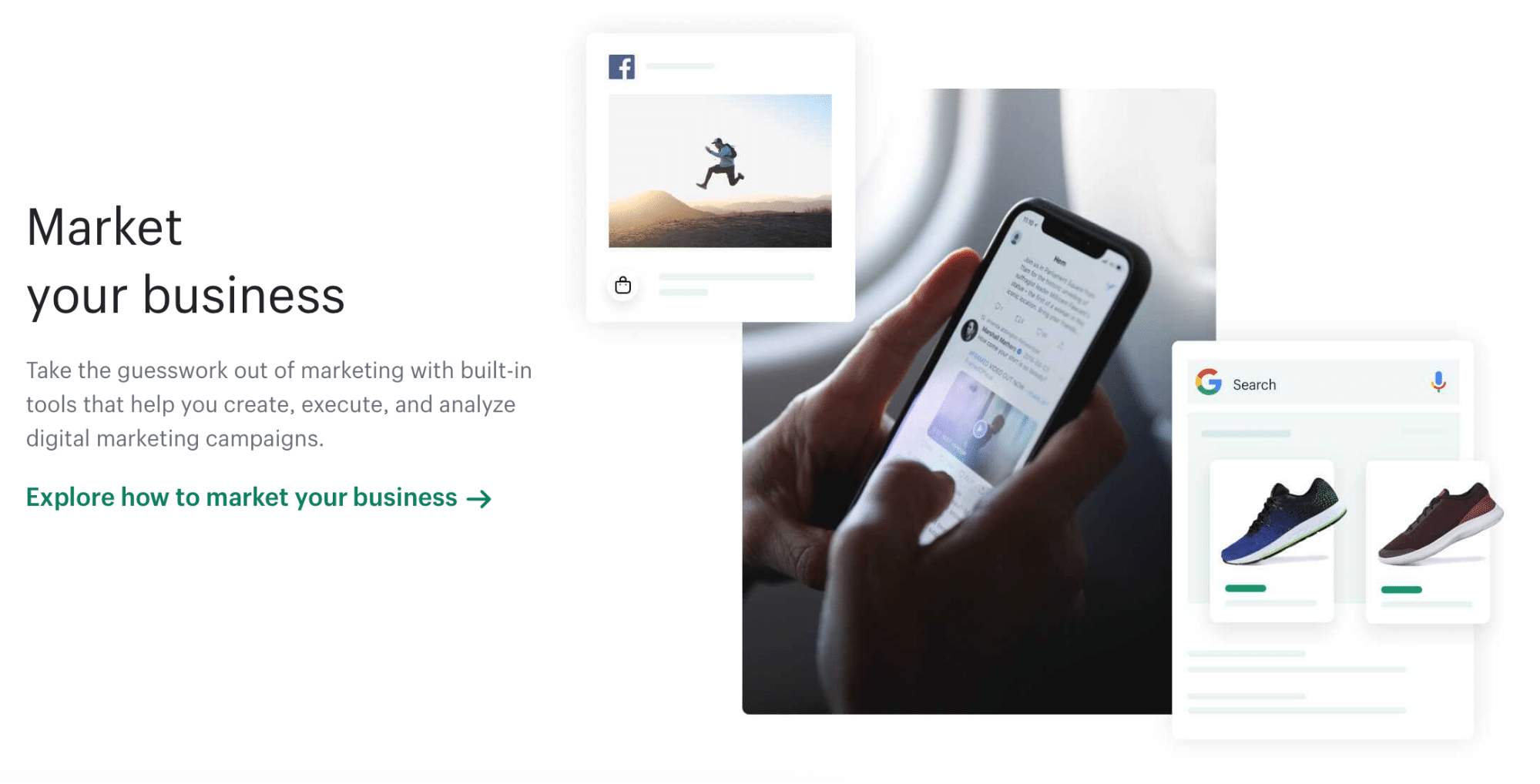
Image from Shopify.com
Arguably, Shopify is the best platform at selling. It’s great for dropshipping and relying on social media marketing. It’s easy to get set up, and you can get selling extremely quickly. It can be great for scaling your business, and they have a large community of independent developers and experts ready to help you.
However, some people criticise Shopify for the costs. It has a minimal amount of free designs and templates, meaning that it can be difficult to create an original looking store. It also doesn’t do the best for SEO performance.
Shopify has a mobile app which means you can keep an eye on sales on the go. Here’s what customers on the Google Play store had to say about it:
Absolutely Love the Shopify app, does exactly what I need it to do, and does it well – Travis.
I chose Shopify for my business and wasn’t sure if I was going to like it after being with another carrier for years. Still, honestly, the mobile functionality was the tiebreaker for me! I can do so much from my phone, allowing me to keep up with trends – Roberta I.
Fantastic App. You always know how your business is doing at your fingertips – Tori.
b. Magento.
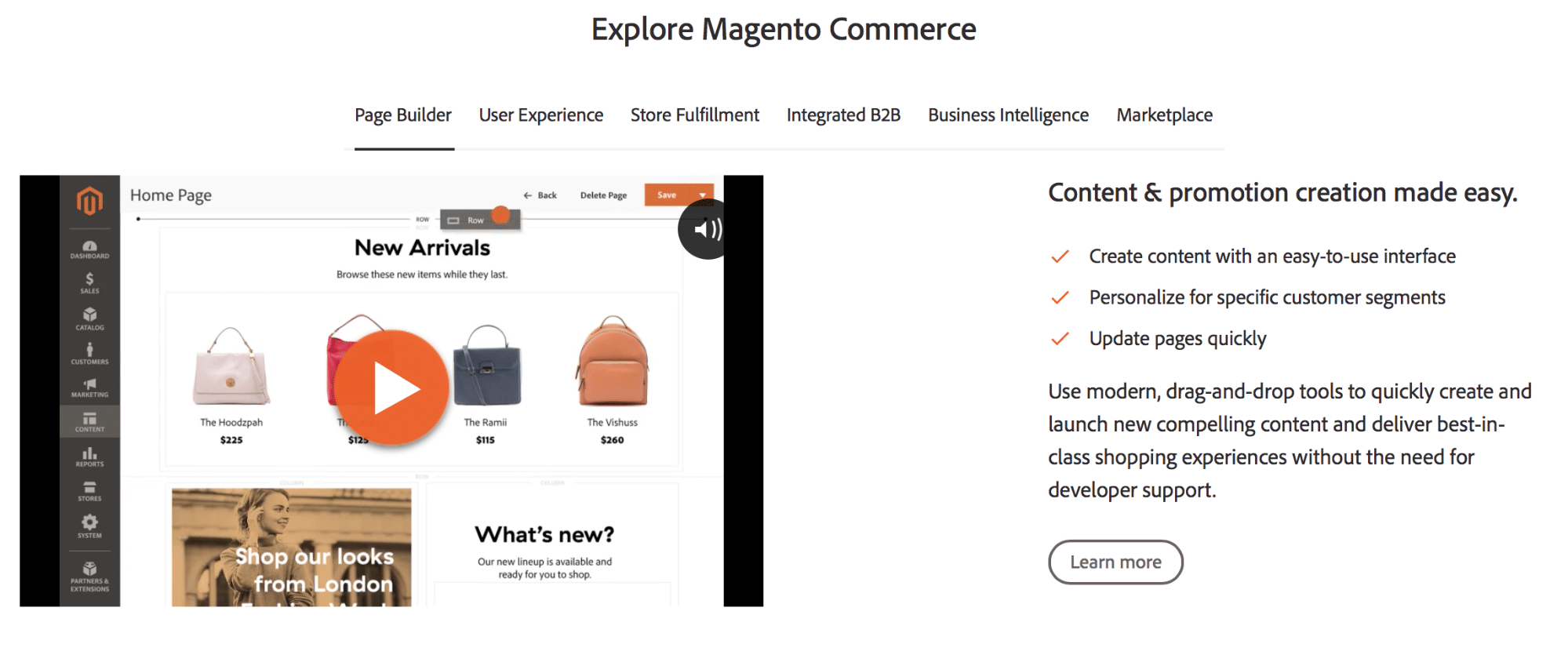
Image from Magento.com
Magento is used by large brands like Nike and Procter & Gamble. It’s a great choice if you have plenty of money to spend, as coding is included in the package. Unlike Shopify, Magento allows for lots of creativity in web design. You can play around for hours, creating the store that you want.
It also creates a community around buying, with a marketplace and one-click selling apps available.
So, what are the drawbacks? While Magento offers a free basic service, the themes can become pretty pricey, and you need developer skills to get the full benefits of the platform. Its app also has some mixed reviews:
Really useful. Highly recommended – Kuldeep S.
Really Good App! Highly recommended. 5+ – Lana E.
Doesn’t seem to work at all on Android? – Misha S.
c. Wix.
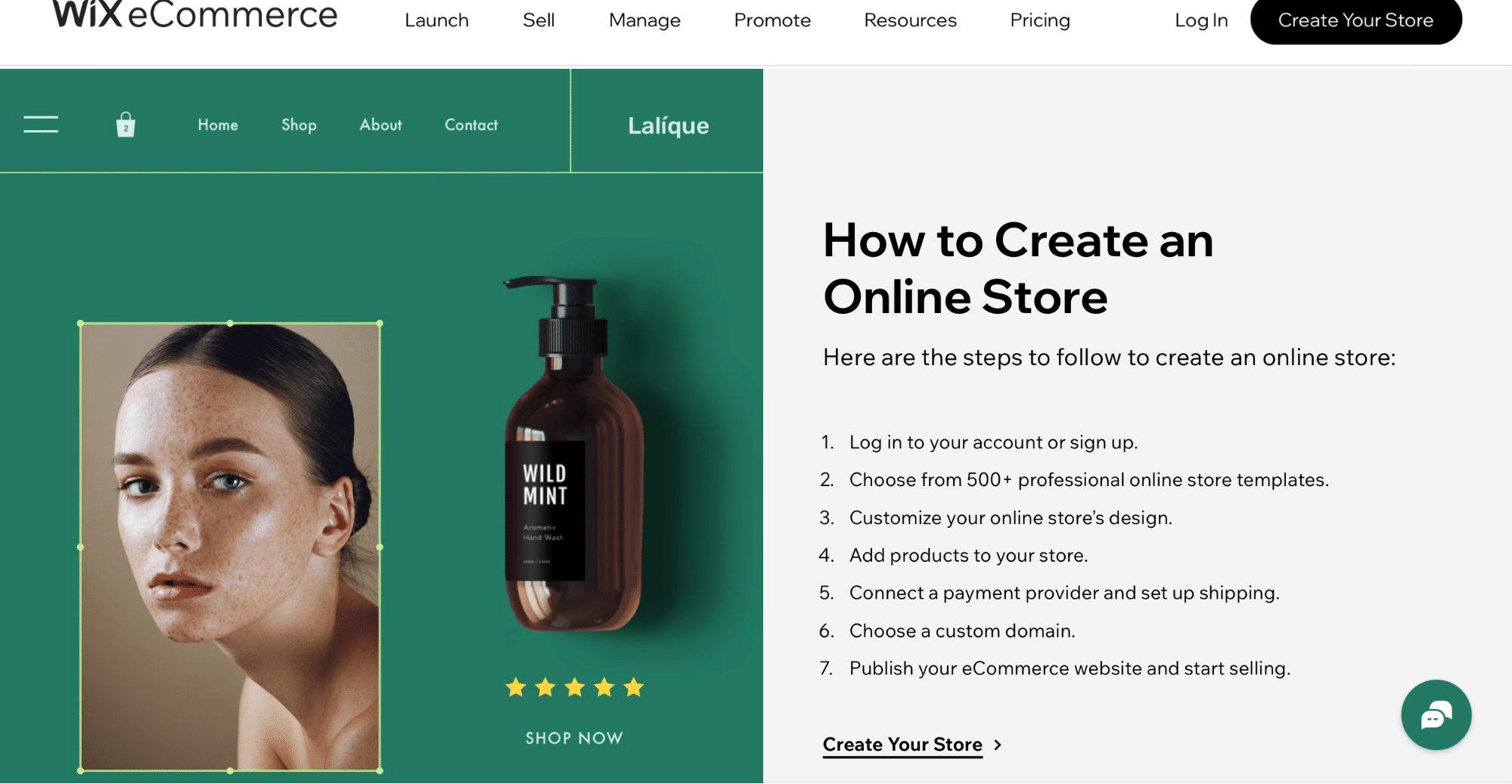
Image from wix.com
You probably know of Wix as a website builder. However, Wix Ecommerce is rapidly growing and is becoming one of the leading competitors. It has tonnes of free designs and themes, making it a popular choice for those starting on a tight budget (a whopping 72 in comparison to ten on Shopify).
While it was previously a straightforward platform, it now offers multi-channel integration, abandoned cart recovery, dropship, and print on demand capabilities.
Like Shopify, however, Wix eCommerce isn’t great for SEO. While improvements have been made, it still doesn’t help businesses to perform as well as possible. There is also a bit of a storage issue, as the storage space is 20GB which may not be big enough for some businesses.
Here’s what customers had to say about it:
The app is excellent, but it lacks many important features, such as making tasks or linking elements to other apps. Add more things to the free plan – Pritam S.
It was so smooth. Really loved it. Wix is perfect; you don’t need to learn coding to make it happen. It is quite intimidating in the beginning, but it gets easier and easier. The concept is perfect – Agrima G.
Experience with this app is so bad for me. I can’t upload anything after two posts. I can’t have any help or access. Sorry but it needs development – Sowmya A.
d. BigCommerce.
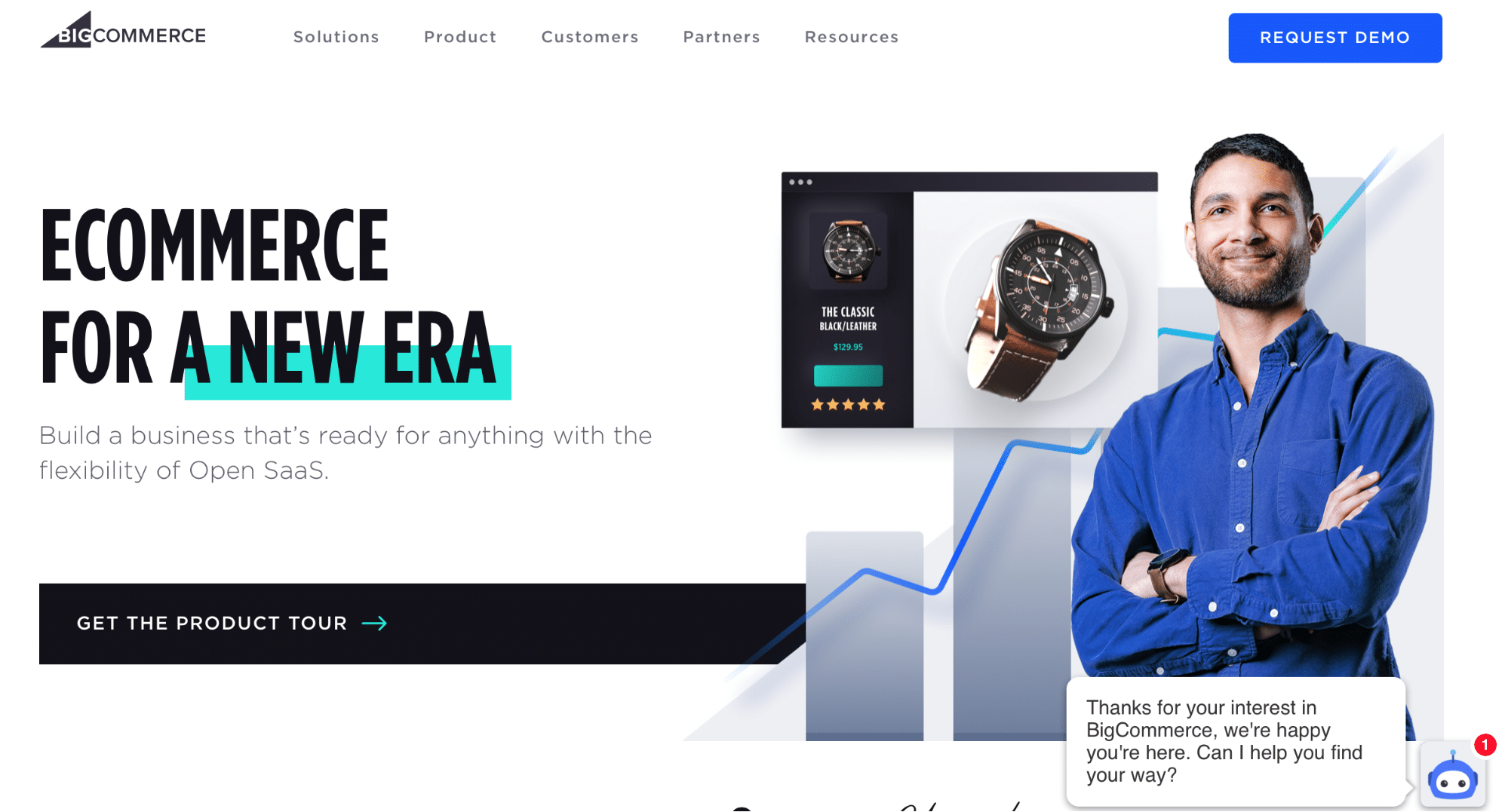
Image from bigcommerce.co.uk
BigCommerce is another leading eCommerce platform and often voted the one with the overall best performance. It has a robust search engine, making it ideal for bigger businesses. It’s also great for businesses that are a little more niche, as it allows for specific searching.
People like BigCommerce because you don’t need to know how to code, unlike Magento. However, if you are tech-savvy and want to do some fiddling, the option to tweak the HTML and CSS is available. It’s also pretty cheap for the entry plan.
So, what’s the catch? BigCommerce can become expensive when you want to sell at a high volume. The entry plan also lacks some key features, such as 1-click selling and cart abandonment.
Here’s what reviews said about the app:
Great app. The only downside is you can’t easily search the products to change inventory levels. Hopefully, they fix this issue – Jeffrey M.
So far, my switch from Shopify to BC has been great. Support is A1… The app, though… Well, it notifies you when you get orders, and they’re pretty straight forward…Other than that, the app is pretty basic – Carlos S.
I’m grateful they dropped an app for this platform. Great for managing orders, accounts, products, and you get your charts right in front of you! – Tom L
7. Create your marketing plan.
“Business has only two functions — marketing and innovation” – Peter Drucker.
Marketing is all about engaging customers. This means it’s potentially the most important part of starting any successful business. Without a marketing plan, no one will find your products.
Unfortunately, products don’t sell themselves, no matter how great they are. You can’t leave sales up to chance. You need to explore avenues that may include content marketing, affiliate marketing, and other examples of digital marketing.
Marketing is all about giving people a nudge in the right direction. People are searching for products like yours – so a good marketing strategy gets your products at the top of the search page. It’s why Amazon always comes up as the first option when you search for a product. Amazon does marketing well, and by doing so, it has become the leading marketplace.
Here’s a mini-guide on creating a marketing plan.
a. Optimising web-page.
All smart business owners optimise their web-page. This is the process of using tools, advanced strategies, and experiments to improve the performance of your website. Thus further driving more traffic, increasing conversions, and growing revenue. Essentially, it means getting more eyes on your pages.
So, how do you optimise a web-page? These are the top basic steps:
- Analyse your website data: you can’t start optimising until you know more about the way people are behaving on your web-page. How have they got there? How long are they spending on it? What are they clicking on? Knowing this helps to tailor your method and use data-based findings to see tangible results.
- Conduct thorough keyword research: everyone’s always talking about keywords. But the fact is that they really help. SEO relies heavily on keyword research. Use tools like Backlinko’s keyword tool to help find keywords related to your business niche.
- Create top-quality content: attract people to your page by writing interesting, educational, and engaging pieces of content. The longer the post, the better it performs, too. This will help with your rankings and direct more traffic to your page.
- Optimise for on-page SEO: SEO is all about knowing where to put the right words. Think about headlines, subheadings, URL slugs, and meta tags, and sprinkle your keywords throughout. Don’t keyword-stuff else people will quickly grow tired of your content.
- Optimise for off-site SEO: off-site SEO refers to all your other pages that aren’t your web-pages, such as your social media profiles, guest blogs, and influencer marketing. These can improve your site’s SEO, too.
- Optimise the website for mobile: everyone’s using a phone these days. People want to be able to see a web-page clearly when using a phone, instead of having to zoom in and out on a page that has clearly only been built for a computer. Make it as user-friendly as possible to drive mobile sales.
- Speed up the pages: no one wants to use a slow, clunky website. A lead will quickly get bored and click back instead of going onto the page. Ensure that your pages are as quick as possible.
- Get quality backlinks: when a high-quality site links back to yours, Google sees that as a sign of your credibility, and ranks you higher. The more relevant and authoritative backlinks you have, the better you rank. So, make some worthy contacts and try to get them to feature you in a post. It’s tit for tat – if you can show that you’ve backlinked them, they may do the same for you.
b. Quick guide to email marketing.
Is email dead? Some think it could be heading that way. With inboxes quickly getting clogged up, most emails only get a quick skim read.
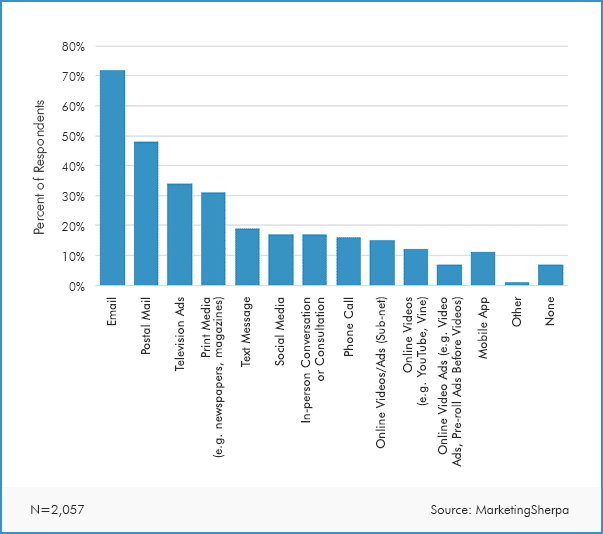
Graph from marketingsherpa.com
However, at least 99% of consumers check their email daily, which means that it isn’t time to arrange the funeral just yet. A successful email campaign can easily boost your business and generate more sales.
Here’s a quick guide to email marketing:
- Create a targeted list.
Who is your email going to? Any great email campaign starts with an email list full of qualified leads that are interested in what you have to offer. This might be people who have engaged with your site but haven’t made a purchase, have asked questions, or have signed up to your newsletter.
- Know your audience.
A great email campaign works for its audience. Gather data from Google Analytics and your social media pages to understand your target market. This means you can create an email campaign that appeals to the right people.
- Create great opt-ins.
Obviously, you need people to sign up to receive your great email campaign. How? Create great opt-ins. Experiment with different types of opt-in forms on different parts of your site, including:
- Welcome gates: these appear as soon as people arrive on your site.
- Lightbox popups: these can appear on any page and temporarily blank out the rest of the content to focus on the opt-in. They have great conversion rates.
- Exit-intent popups: these appear when people are about to leave the site.
- Plan follow-ups.
Follow-ups are the meat of the campaign. You need to create a schedule for your emails. But don’t overwhelm your subscribers by emailing too often. You’ll need to get some good planning software. There’s a great variety of choice, such as Asana or Mailchimp.
- Craft your subject line.
Hey you! Have you received emails like this before?
Email campaigns with enticing subject lines always work best. Some might use your name or try to draw you in with a question or bold statement.
The subject line is important because it’s the first thing your recipient will see. It determines whether they open the email or delete it immediately. If the subject line is boring or bland, chances are they won’t open it. So, take the time to plan fun, exciting, and intriguing subject lines to get people clicking.



- Write great copy.
The quality of your email copy is important. It should be well written, clear, and informative. Typos and grammatical errors undermine your business. If you’re not confident in your writing skills, try hiring a freelancer.
c. Social media marketing.
Social media is where it’s at – especially if your target audience is young. Millennials are the social media generation, with most having Facebook, Instagram, and Twitter accounts.
For an even younger target audience, you might want to try using Snapchat and TikTok. But how do you use social media for marketing?
It’s pretty straightforward. Create short-form visual content – especially on Instagram. Post regular and often. Use hashtags. Gifs and memes perform well, especially when they’re funny. Make sure your social media content matches your brand. Selling fun products and blogging with a tongue-in-cheek style? Have some jokes on your social pages, too. Selling fitness gear? Keep your page motivational.
You should also reach out to influencers. The clothing brand, Lucy and Yak, is a great example of a small business that started online and regularly collaborated with like-minded ethical influencers. They host yoga videos, painting groups, and other organisations on their Instagram page, all wearing their classic branded dungarees. This creates a buzz around their products through a community of influencers, artists, and creatives.

Image from LucyandYak.com
8. Roll-out your online store.
So, it’s finally time to roll-out your online store. This is a big moment, and you want it to go well. While there are plenty of things to consider, don’t forget that you can continue tweaking even after you’ve rolled-out your online store. The key is to get things moving and start making sales.
a. Some tips when launching.
Here are a few tips and things to check over before the big launch:
- Add your chosen sales channels: don’t forget that you can add other channels to your chosen eCommerce platform. This might be Amazon, eBay, Etsy, Facebook Marketplace, Pinterest, etc.
- Review your checkout experience: you don’t want customers to get to your online store and get blocked from making a purchase somewhere. Double-check everything beforehand, and make sure it all runs smoothly. This includes checking discount codes work, shipping rates are calculated, and an email notification is sent to confirm the purchase as well as ensuring customers can buy with a credit card, e-wallet, and any other way they may desire.
- Add a custom domain: creating a custom domain takes seconds, but it really makes a difference. It simply makes your business easier to find. Normally, it’s the name of the site (Facebook) followed by .com (Facebook.com).
- Optimise all images: there we have it again: optimisation. What do optimising images mean? It’s simple – it just means that they work with your site and load quickly. Keep them small, choose the right file type, and don’t forget about thumbnails.
9. Scaling your business.
“Growth is never by mere chance; it is the result of forces working together” – James Cash Penney, founder JCPenney.
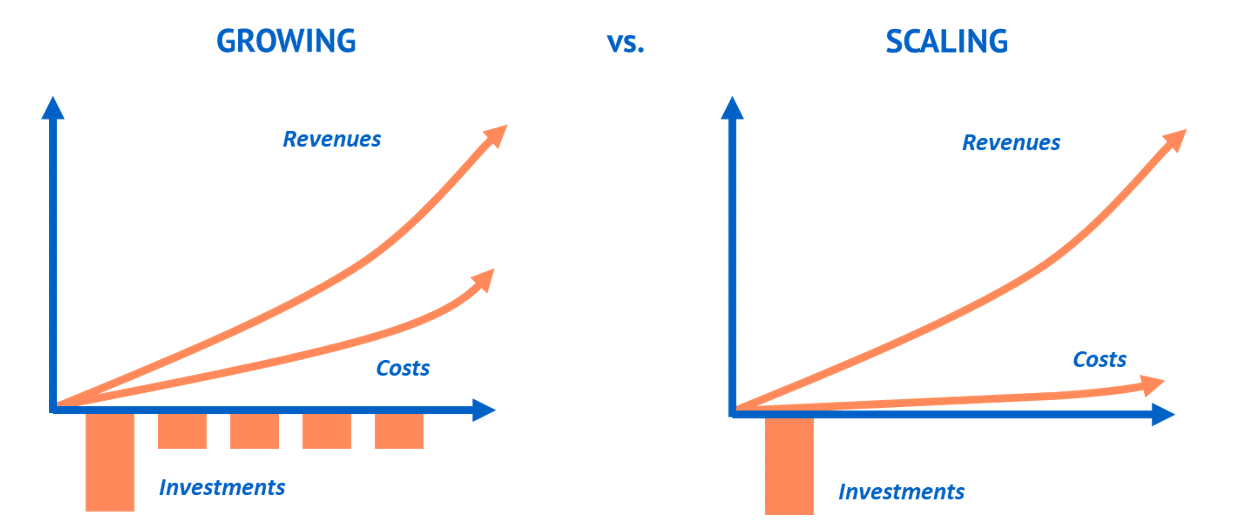
Graph from smartbusinessmodeler.com
All business owners want to make the most out of their business and see it become as successful as possible. A small business might not always stay small. After you’ve seen some success for your online business, it might be time to think about scaling.
Scaling an online business can be difficult. Business owners often find that after they have decided to start an online business, it gets limited success fairly swiftly. But becoming bigger is harder. You’ll start to compete with bigger brands and people expect more sophisticated services. A small business might get away with a mistake with shipping, but a big business will be criticised – and fast.
Scaling an online business is all about planning and setting goals. For example, you should:
- Think about what you want to become, not what you are
- Make sure you’re ready for growth. Is your business performing well enough?
- Learn from competitors who have recently grown in a way that you aspire to
- Hire highly engaged employees who want the business to succeed as much as you do
- Seek the advice of experts when needed
If you’ve already created a small business that’s doing well, scaling shouldn’t be too difficult. However, you will need to anticipate hurdles and have a great plan in place to predict any shortcomings.
Conclusion
Wanting to start an online business is admirable. You’ve seen that the internet holds thousands of opportunities, and you are using the tools available to create a business.
While starting an online business can have its challenges, it’s all about planning, perseverance, and positivity. Many people have done it before. Why can’t you? By following this guide and keeping your eye on the ball, you will undoubtedly see results.
Communicate seamlessly in your business with the RingCentral all-in-one business communication plan specially created for business start-ups.
Get details on the security and trust built into RingCentral products and services.Download the white paper
Originally published Jan 17, 2023, updated Apr 08, 2024



